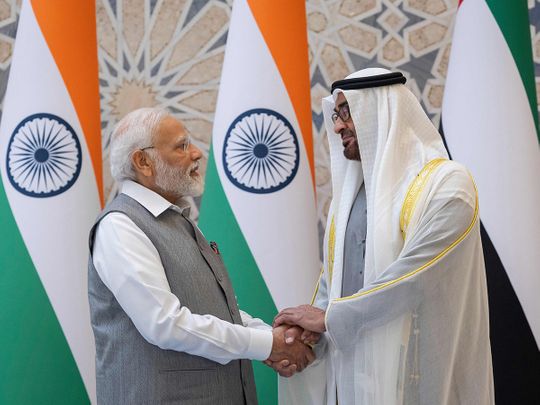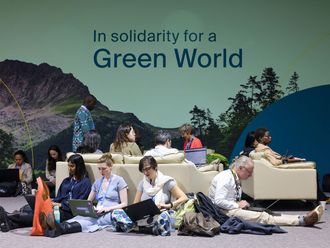
The trajectory of India’s foreign policy carries the weight of history and the scent of transformation. A gem in this necklace of evolving relationships is the bond between India and the United Arab Emirates (UAE).
To understand this, let’s borrow the words of the scholar, Samuel P. Huntington, who once said, “The West won the world not by the superiority of its ideas or values or religion but rather by its superiority in applying organised violence. Westerners often forget this fact, non-Westerners never do.”
In the first few decades post-independence, India found itself swinging like a pendulum in the hall of global power politics. Jawaharlal Nehru sowed the seeds of a non-aligned India amid the tumultuous winds of the Cold War. As the curtain fell on the Cold War era, India found itself standing at a diplomatic crossroads.
Recognising the turning tides of global politics, it decided to ride the wave of economic liberalisation, in the process recasting its foreign policy priorities. This shift ushered a new era of engagement with regions far beyond its traditional spheres, including the Middle East, and in particular, the UAE.
Read more
- UAE President Sheikh Mohamed meets Indian Prime Minister Narendra Modi in Abu Dhabi
- In pictures: UAE President Sheikh Mohamed receives Indian PM Narendra Modi
- India’s IIT-Delhi to set up first international campus in Abu Dhabi with ADEK
- UAE and India issue joint statement after Indian PM's visit to UAE
A strategic transformation
Under the Prime Minister Narendra Modi since 2014, India’s foreign policy has undergone a strategic transformation. The country has transitioned from strict non-alignment to building stronger relationships with major and middle-sized powers globally.
The country’s foreign policy has also demonstrated a commitment to promoting peace and cooperation, as highlighted by India’s active engagement in various international groupings, bilateral, trilateral, quadrilateral, and multilateral activities worldwide.
The bond between India and the UAE bloomed, driven by economic potential and strategic alignment. Furthermore, the Indian diaspora in the UAE has played a significant role in enhancing the bilateral relationship between the two countries, serving as a link of connectivity, cultural exchange, and economic cooperation.
Comprising approximately 38% of the total residents in the UAE, the Indian community has not only contributed to the UAE’s socioeconomic development but has also significantly influenced India-UAE relations.
A beautiful metaphor to illustrate this is to think of the iconic ‘Palm Jumeirah’ in Dubai. Like the palm tree that stands tall amid the desert, the India-UAE relationship has grown, braving the arid complexities of geopolitics.
Promising era in India-UAE ties
Since Prime Minister Narendra Modi assumed office in India in 2014, the relations between India and the UAE have seen significant advancement. PM Modi’s first visit to the UAE in 2015, which was the first by an Indian leader in 34 years, marked the commencement of a promising era in India-UAE ties. This signalled a strategic shift towards the Middle East in India’s foreign policy.
One of the major milestones in this relationship was the establishment of a comprehensive strategic partnership, making the UAE the first country in the region to establish such a relationship with India. This was followed by similar partnerships with Saudi Arabia and Egypt.
The personal chemistry between President His Highness Sheikh Mohamed bin Zayed Al Nahyan and PM Modi has played a crucial role in fortifying this partnership.
Economic engagement has been at the forefront of this burgeoning relationship. Bilateral trade has seen significant growth, reaching $85 billion, with a target of $100 billion.
The Comprehensive Economic Partnership Agreement (CEPA) signed in 2022 aimed to boost bilateral trade to $100 billion within the next five years. The sectors set to benefit from this agreement include textiles, gems, jewellery, leather goods, and food processing.
On the geopolitical front, India, in collaboration with the United States, Israel, and the UAE under the banner I2U2, established a joint working group to coordinate strategy in the Middle East, revealing overlapping interests in energy, climate, trade, and regional security.
Prime Minister Modi’s latest visit to the UAE has further solidified the deep-rooted alliance between the two nations. The discussions ranged from India’s presidency of the G20 and the UAE’s presidency of COP28, to burgeoning academic partnerships between institutions in both countries.
However, the crowning accomplishment of this visit was the proposal to inaugurate a Local Currency Settlement System (LCSS). The freshly inked Memorandums of Understanding (MoUs) between India and the UAE for the creation of an LCSS for INR-AED exchanges are poised to deliver manifold advantages to both countries.
$100 billion trade target
(1) Reduced Transaction Costs and Time: The system optimises transaction costs by avoiding exchange rate risks and charges associated with a third-party currency, usually the US dollar. Further, it also reduces settlement time, making cross-border transactions faster and more efficient.
(2) Facilitation of Investments and Remittances: The new arrangement facilitates investments and remittances between the two nations. It covers both current and capital account transactions, allowing for a wider range of transactions to be performed.
(3) Promotion of INR-AED Foreign Exchange Market: The agreement encourages the development of an INR-AED foreign exchange market, thereby fostering economic ties between India and the UAE. It boosts their respective local currencies in international trade, reducing dependence on a third-party currency.
(4) Strengthening Economic Collaboration: The arrangement not only promotes cross-border transactions but also strengthens economic collaboration between the two nations. It represents a significant step towards achieving a $100 billion trade target set by both countries.
(5) Integration of Payment Systems: Alongside LCSS, the MoU includes linking India’s Unified Payments Interface (UPI) with the UAE’s Instant Payment Platform (IPP). This integration will further simplify and speed up cross-border financial interactions. India and UAE are also exploring links between card switches and payment messaging system integration, adding to the convenience of cross-border transactions.
The India-UAE relationship is not just a mere alliance, it is a dynamic synergy sculpted by shared interests and mutual respect.
This evolution of India-UAE relationship, charting a trajectory from shared history to shared future, is a powerful reminder of the transformative power of diplomatic sagacity and strategic alignment.
Bibek Debroy (@bibekdebroy) is the Chairman, Economic Advisory Council to the Prime Minister of India and Aditya Sinha is Additional Private Secretary (Policy & Research), Economic Advisory Council to the Prime Minister








